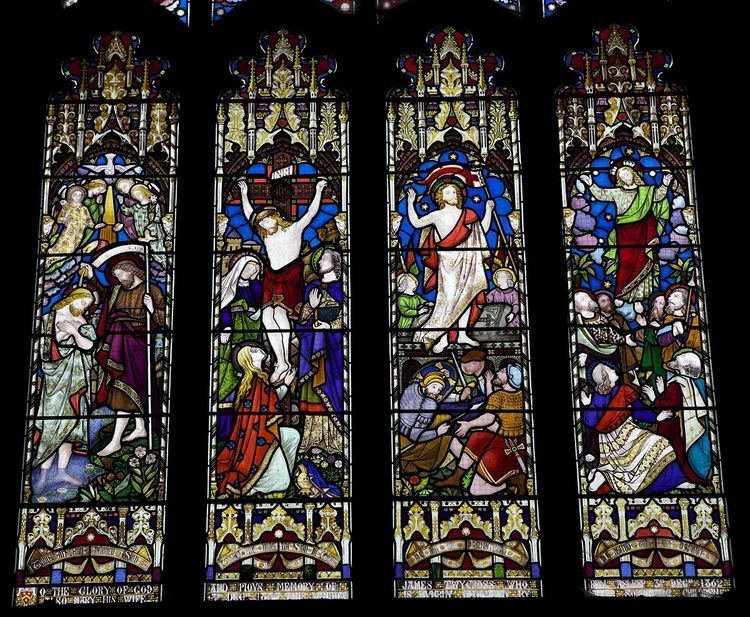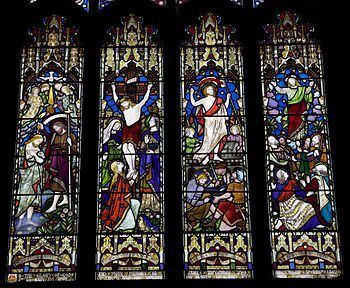Name William Holland Role Stained glass maker | Died 1883 | |
 | ||
William Holland (1809 – September 27, 1883) was a 19th-century British maker of stained glass and other decorative pieces. His work is represented in churches and stately homes across southern England, Wales, and Ireland. Holland of Warwick windows can be identified by his mark "Guil Holland Vaivic. Puix " written on a scroll in Latin in the lower right hand corner. Holland's stained glass reflects the influence of the Cambridge Camden Society and the Gothic Revival work of Thomas Willement. Willement revived in the early 19th century, the method used at York Minster to build the Great East Window in 1400 wherein coloured pieces are leaded and the lead then becomes part of the design, appearing as black lines in the window.
Contents
- Studio and business
- Studio in later years
- Representation at Great Exhibition
- Stained glass in the nineteenth century
- Examples of Holland Studio stained glass windows
- Church of Ireland
- References

Studio and business
Holland founded his firm in Warwick at 3 Priory Rd at the intersection with St John's Road, as "Holland , William and Son, St John's , Warwick . Designers and Producers. Stained glass of the twelfth century representing scriptural events." Other 19th century sources quote his work as Elizabethan style. Again as a "stained glass and decorative painting establishment, where every description of design for monumental and baronial windows, enamelled and encaustic painting, gilding, imitations of wood" was executed. At his studio, Holland also trained family members and other well known makers of stained glass, such as Clement Heaton In 1855 Heaton joined James Butler to start his own company in London. The original buildings still stand, a white office on a corner is still attached to a long brick building which was Holland's workshop.
Studio in later years
William's sons also became experts in stained glass, and a nephew, Frank Holt (1843–1928), joined the firm after which it was known as Holland & Holt and continued on as Holt of Warwick into the early years of the twentieth century.
Representation at Great Exhibition
William Holland's stained glass was exhibited at the Great Exhibition of 1851 which was held in Hyde Park, London, from 1 May to 15 October, and is found in the Official Catalogue . The catalogue lists exhibitors and also a description of various methods used to produce stained glass windows. Glass is found in Section III, Class 24.
Holland is listed in entry 63 in the catalogue as working in various styles:
He was one of 25 makers of stained glass listed.
Stained Glass was exhibited lining the eastern walls of the Central North gallery of the Crystal Palace. Around 1845 there was a revival of interest in all types of worked glass, reflected in the choice of panes of sheet or window glass 49 inches long to cover the exhibition halls. "It has been a popular notion that this art was lost to us ; such is not the case, it has indeed been dormant, but never extinct. The fine works exhibited this year (1851) - the production of living artists- announce its revival." This was the first time that stained glass was exhibited in an extraordinary setting that emphasized its artistry in addition to religious themes. Displays were set up to explain the process of glass making. A batch of flint glass was made from one part alkali, two parts lead, and three parts sand with the best quality sand found at Alum Bay, Isle of Wight and Aylesbury, Buckinghamshire . "The materials are mixed and then melted in a crucible made of fire clay, a substance that can withstand intense, prolonged heat. Melting takes 60 hours. At 12 hours the glass is honeycombed and very white and opaque and a few hours later is transparent with thousands of air bubbles, which eventually disappear along with the light purple tint: that is oxygen given off by the oxide of manganese. Tools are then used to manipulate the glass." Flashed (two layers of colour) and stained glass are coloured on the surface only and through a process of embossing the white surface beneath is revealed. This was the process most likely used by Holland to illustrate his windows.
Stained glass in the nineteenth century
During the English Civil War in the 16th century Oliver Cromwell, a zealous Puritan, fought King Charles II and as part of this campaign, rampaged against the traditional Loyalist church and its ornate trappings. His troops broke down the heavy doors of parish churches near and far, and rode on horseback through their interiors, destroying with their swords anything decorative. Priceless and ancient stained glass windows were shattered and the churches were laid bare to the elements through empty window frames. In the Nineteenth century the Anglican church became interested in what had been lost: there were a few examples of medieval and Elizabethan windows that had survived this earlier devastation. William Holland's stained glass windows strongly reflect his interest in this period as he described his work to be "Stained glass of the twelfth century representing scriptural events." Religious revivals also influenced architecture and were the motivating factor in rebuilding churches. During a flowering period of reconstruction, older windows with plain glass and leading were replaced. See also British and Irish stained glass (1811–1918) and the Cambridge Camden Society.
Examples of Holland Studio stained glass windows
Church of Ireland
Christ Church, Taney Dundrum incorporates a set of windows signed " Holland, Son & Holt, Glass Painters, Decorators, &c., Warwick, England, 1872."and "Studio William Holland; Warwick ".
In the EAST Sanctuary a very large stained glass window is described as "Five lancets each measuring 3760mm x 560mm; rose of one 6-foil and ten quatrefoils; two large mouchettes and several small lights."
Iconography: King Solomon Building the Temple
Moses in the Bullrushes
Moses and the Brazen Serpent
Elijah Ascending to Heaven
Abraham Sacrificing Isaac
King Solomon in the Temple
Moses and the Tables of the Law
The SOUTH Sanctuary displays "One lancet measuring 2840mm x 560mm. "
Iconography:Visiting the Prisoner
In the NORTH; EAST chancel are "Two lancets, each measuring 2950mm x 560mm, one quatrefoil and two mouchettes. "
Iconography:Taking in the Stranger- on left
Clothing the Naked- on right
In the NORTH; WEST chancel are "Two lancets each measuring 2950x560 mm, one quatrefoil and two small mouchettes. "
Iconography:Feeding the Hungry- on left
Giving Drink to the Thirsty- on right
